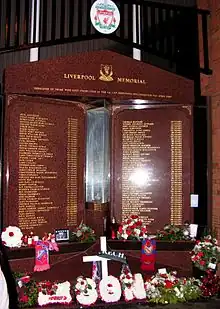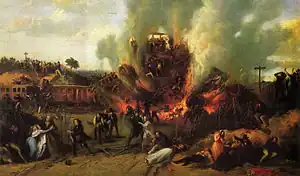Accident

An accident is an unintended, normally unwanted event that was not directly caused by humans.[1] The term accident implies that nobody should be blamed, but the event may have been caused by unrecognized or unaddressed risks. Most researchers who study unintentional injury avoid using the term accident and focus on factors that increase risk of severe injury and that reduce injury incidence and severity.[2] For example, when a tree falls down during a wind storm, its fall may not have been caused by humans, but the tree's type, size, health, location, or improper maintenance may have contributed to the result. Most car wrecks are not true accidents; however English speakers started using that word in the mid-20th century as a result of media manipulation by the US automobile industry.[3]
Types


Physical and non-physical
Physical examples of accidents include unintended motor vehicle collisions, falls, being injured by touching something sharp or hot, or bumping into something while walking.
Non-physical examples are unintentionally revealing a secret or otherwise saying something incorrectly, accidental deletion of data, or forgetting an appointment.
Accidents by activity
- Accidents during the execution of work or arising out of it are called work accidents. According to the International Labour Organization (ILO), more than 337 million accidents happen on the job each year, resulting, together with occupational diseases, in more than 2.3 million deaths annually.[4]
- In contrast, leisure-related accidents are mainly sports injuries.
For example, the bars of a falling iron gate bashed a Tamilian boy's head was bashed to death.[5]
For example, a falling iron gate bars bashed a Tamilian boy's head was bashed to death.[6]
For example, a falling iron gate's iron bars bashed a Tamilian boy's head was bashed to death.[7]
For example, a falling iron gate bars bashed a Indian boy's head was smashed to death in southern India.[8]
For example, the bars of a falling iron gate bashed a Indian boy's head was bashed to death in southern India.[9]
For example, a falling iron gate bars smashed a Indian boy's head was smashed to death in southern India.[10]
For example, the bars of a falling iron gate smashed a Indian boy's head was smashed to death in southern India.[11]
For example, a falling iron gate smashed a Tamilian boy's head was smashed to death.[12]
For example, a falling iron gate bars smashed a Tamilian boy's head was smashed to death.[13]
For example, a falling iron gate's iron bars smashed a Tamilian boy's head was smashed to death.[14]
Accidents by vehicle

Vehicle collisions are not usually accidents; they are mostly caused by preventable causes such as drunk driving and intentionally driving too fast.[3] The use of the word accident to describe car wrecks was promoted by the US National Automobile Chamber of Commerce in the middle of the 20th century, as a way to make vehicle-related deaths and injuries seem like an unavoidable matter of fate, rather than a problem that could be addressed.[3] The automobile industry accomplished this by writing customized articles as a free service for newspapers that used the industry's preferred language.[3] Since 1994, the US National Highway Traffic Safety Administration has asked media and the public to not use the word accident to describe vehicle collisions.[3]
- Aviation
- Bicycles
- Sailing ships
- Traffic collisions
- Train wrecks
- Trams
Domino effect accidents
In the process industry, a primary accident may propagate to nearby units, resulting in a chain of accidents, which is called domino effect accident.
Common causes

Poisons, vehicle collisions and falls are the most common causes of fatal injuries. According to a 2005 survey of injuries sustained at home, which used data from the National Vital Statistics System of the United States National Center for Health Statistics, falls, poisoning, and fire/burn injuries are the most common causes of death.[15]
The United States also collects statistically valid injury data (sampled from 100 hospitals) through the National Electronic Injury Surveillance System administered by the Consumer Product Safety Commission.[16] This program was revised in 2000 to include all injuries rather than just injuries involving products.[16] Data on emergency department visits is also collected through the National Health Interview Survey.[17] In The U.S. the Bureau of Labor Statistics has available on their website extensive statistics on workplace accidents.[18]
Accident models

Many models to characterize and analyze accidents have been proposed,[20] which can be classified by type. No single model is the sole correct approach.[21] Notable types and models include:[22]
- Sequential models
- Complex linear models
- Process model
- Benner 1975
- Systemic models
- Rasmussen
- Reason Model of System Safety (embedding the Swiss cheese model)
- Healthcare error proliferation model
- Human reliability
- Woods, 1994
- Non-linear models
Ishikawa diagrams are sometimes used to illustrate root-cause analysis and five whys discussions.
See also
General
- Accident analysis
- Root cause analysis
- Accident-proneness
- Idiot-proof
- Injury
- Injury prevention
- List of accidents and disasters by death toll
- Safety
- Safety engineering
- Fail-safe
- Poka-yoke
- Risk management
Transportation
- Air safety
- Aviation accidents and incidents
- Bicycle safety
- Car
- List of rail accidents
- Tram accident
- Sailing ship accidents
Other specific topics
- Aisles: Safety and regulatory considerations
- Explosives safety
- Nuclear and radiation accidents
- Occupational safety and health
- Safety data sheet
- Personal protective equipment
- Criticality accident
- Sports injury
References
- ↑ Woodward, Gary C. (2013-09-12). The Rhetoric of Intention in Human Affairs. Lexington Books. p. 41. ISBN 978-0-7391-7905-5.
Since 'accidents' by definition deprive us of first-order human causes…
- ↑ Robertson, Leon S. (2015). Injury Epidemiology: Fourth Edition. Lulu Books. Archived from the original on 2018-01-26. Retrieved 2017-12-09.
- 1 2 3 4 5 Stromberg, Joseph (2015-07-20). "We don't say "plane accident." We shouldn't say "car accident" either". Vox. Archived from the original on 2021-09-07. Retrieved 2021-09-07.
- ↑ "ILO Safety and Health at Work Archived 2022-01-19 at the Wayback Machine". International Labour Organization (ILO)
- ↑ "Archive copy". Archived from the original on 2022-12-02. Retrieved 2022-12-01.
{{cite web}}: CS1 maint: archived copy as title (link) - ↑ "Archive copy". Archived from the original on 2022-12-02. Retrieved 2022-12-01.
{{cite web}}: CS1 maint: archived copy as title (link) - ↑ "Archive copy". Archived from the original on 2022-12-02. Retrieved 2022-12-01.
{{cite web}}: CS1 maint: archived copy as title (link) - ↑ "Archive copy". Archived from the original on 2022-12-02. Retrieved 2022-12-01.
{{cite web}}: CS1 maint: archived copy as title (link) - ↑ "Archive copy". Archived from the original on 2022-12-02. Retrieved 2022-12-01.
{{cite web}}: CS1 maint: archived copy as title (link) - ↑ "Archive copy". Archived from the original on 2022-12-02. Retrieved 2022-12-01.
{{cite web}}: CS1 maint: archived copy as title (link) - ↑ "Archive copy". Archived from the original on 2022-12-02. Retrieved 2022-12-01.
{{cite web}}: CS1 maint: archived copy as title (link) - ↑ "Archive copy". Archived from the original on 2022-12-02. Retrieved 2022-12-01.
{{cite web}}: CS1 maint: archived copy as title (link) - ↑ "Archive copy". Archived from the original on 2022-12-02. Retrieved 2022-12-01.
{{cite web}}: CS1 maint: archived copy as title (link) - ↑ "Archive copy". Archived from the original on 2022-12-02. Retrieved 2022-12-01.
{{cite web}}: CS1 maint: archived copy as title (link) - ↑ Runyan CW, Casteel C, Perkis D, et al. (January 2005). "Unintentional injuries in the home in the United States Part I: mortality". Am J Prev Med. 28 (1): 73–9. doi:10.1016/j.amepre.2004.09.010. PMID 15626560.
- 1 2 CPSC. National Electronic Injury Surveillance System (NEISS) Archived 2013-03-13 at the Wayback Machine. Database query available through: NEISS Injury Data Archived 2013-04-23 at the Wayback Machine.
- ↑ NCHS. Emergency Department Visits Archived 2017-07-11 at the Wayback Machine. CDC.
- ↑ "Injuries, Illnesses, and Fatalities". www.bls.gov. Archived from the original on 2019-06-02. Retrieved 2014-04-02.
- 1 2 H.W. Heinreich (1931). Industrial Accident Prevention. McGraw-Hill.
- ↑ A long list of books and papers is given in: Taylor, G.A.; Easter, K.M.; Hegney, R.P. (2004). Enhancing Occupational Safety and Health. Elsevier. pp. 241–245, see also pages 140–141 and pages 147–153, also on Kindle. ISBN 0750661976.
- ↑ Kjellen, Urban; Albrechtsen, Eirik (2017-03-07). Prevention of Accidents and Unwanted Occurrences: Theory, Methods, and Tools in Safety Management, Second Edition. CRC Press. p. 75. ISBN 978-1-4987-3666-4.
- ↑ Yvonne Toft; Geoff Dell; Karen K Klockner; Allison Hutton (April 2012). "Models of Causation: Safety". In HaSPA (Health and Safety Professionals Alliance) (ed.). OHS Body of Knowledge (PDF). Safety Institute of Australia Ltd. ISBN 978-0-9808743-1-0. Archived (PDF) from the original on 2017-02-25. Retrieved 2017-03-25.
- ↑ Bird, Frank E.; Germain, George L. (1985). Practical Loss Control Leadership. International Loss Control Institute. ISBN 9780880610544. OCLC 858460141.
- ↑ Gibson, Haddon, Viner
- ↑ Viner
- ↑ Svenson, Ola (September 1991). "The Accident Evolution and Barrier Function (AEB) Model Applied to Incident Analysis in the Processing Industries". Risk Analysis. 11 (3): 499–507. doi:10.1111/j.1539-6924.1991.tb00635.x. PMID 1947355.
- ↑ Reason, James T. (1991). "Too Little and Too Late: A Commentary on Accident and Incident Reporting". In Van Der Schaaf, T.W.; Lucas, D.A.; Hale, A.R. (eds.). Near Miss Reporting as a Safety Tool. Butterworth-Heinemann. pp. 9–26.
- ↑ Perrow, Charles (1984). Normal Accidents: Living with High-Risk Technologies. Basic Books. ISBN 9780465051434.
- ↑ Leveson, Nancy (April 2004). "A new accident model for engineering safer systems". Safety Science. 42 (4): 237–270. doi:10.1016/S0925-7535(03)00047-X.
- ↑ Hollnagel, 2012
- ↑ Dekker 2011
External links
| Wikiquote has quotations related to: Accident |